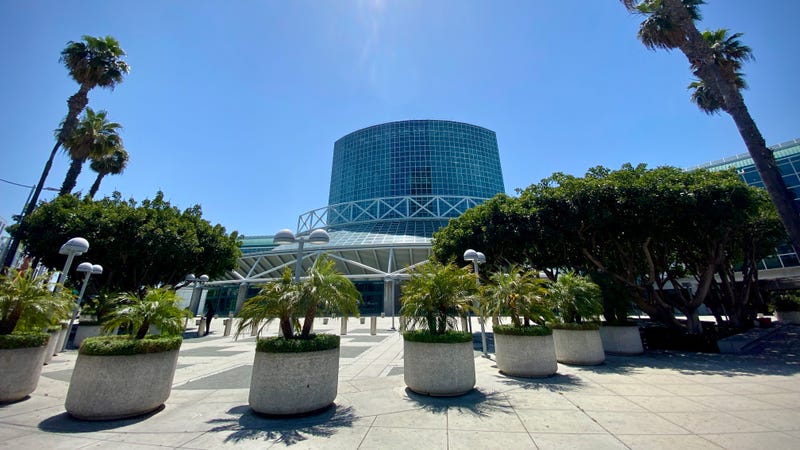
A five-member City Council committee Tuesday advanced a "phased delivery" approach for a proposal to modernize the Los Angeles Convention Center, which is scheduled to host events for the 2028 Summer Olympic and Paralympic Games.
In a unanimous vote, the Economic Development and Jobs Committee recommended a phased delivery option to pursue the project, which would allow some construction starting in September and pause work from May 31 to Sept. 30, 2028, for the 2028 Games with project completion slated for March 2029.
Want to get caught up on what's happening in SoCal every weekday afternoon? Click to follow The L.A. Local wherever you get podcasts.
Officials noted this was a "contemplated" timeline as more work needs to be done to finalize the schedule, costs and other things.
Committee members approved the matter with conditions, and it will now be voted on Wednesday by the full City Council.
"We all agree this is a project we cannot afford not to do," Councilman Curren Price, chair of the EDJ Committee, said.
The project has been years in the making with the Tourism Department and Los Angeles' business community encouraging the expansion as a way to boost tourism and make the city more competitive compared to other convention spaces in San Diego, San Francisco and Anaheim.
Supporters of the project also expressed it would generate millions more in tax revenue. With the Olympics on the horizon, the call to move forward on the project has only grown.
However, in the aftermath of January's wildfires, the city's top budget analyst told City Council members in February that it was no longer feasible to complete the project by May 2028.
On Tuesday, City Administrative Officer Matt Szabo and Chief Legislative Analyst Sharon Tso reiterated that an expedited delivery option for the project would not be feasible. But they also provided a phased delivery option for elected officials to consider if they wish to pursue the expansion.
That option would see the completion of the project months after the 2028 Games have concluded.
With the city facing a $1 billion shortfall in the upcoming fiscal year and as a result of an estimated $350 million in damages to street lights, recreation centers, a library and other infrastructure from the Palisades Fire, Szabo and Tso also provided an option for elected officials to kill the project outright.
Councilwoman Traci Park, who represents Pacific Palisades, said the project entails a lot of uncertainty, but it should not stop them from "doing what needs to be done."
"We're letting our city assets collect dust and deteriorate, while other cities are taking our business hand over fist," Park said. "If we do it right, it's not just going to help our economic recovery, but also our wildfire recovery by bringing visitors to our city and expanding our economic opportunities."
Last year, the City Council authorized $54 million for pre- construction work. The current scope of the project calls for 190,000 square feet of contiguous hall space, up to 55,000 square feet of additional meeting room space; and up to 95,000 square feet of multi-purpose space.
City staff said this design would provide for 750,000 square feet of contiguous hall space and more than 1.2 million square feet of total usable space across the Convention Center campus, which would overall help the city compete with other convention spaces in San Diego, San Francisco and Anaheim.
The project would connect the South Hall and West Hall together above Pico Boulevard, resulting in an 18-month closure for construction. If approved, the project would redesign Gilbert Lindsay Plaza with more public amenities, as well as add digital signs on the outside of the Convention Center.
Council members were not without trepidation as the committee requested further assessments on ways to reduce the price tag of the project -- which has increased to $2.2 billion from an initial estimate of about $1.4 billion.
The new estimate covers construction and design costs and it adds for a new kitchen and concessions program, new electrification requirements, additional steel and structural support for the Pico Expansion, upgrades to fire alarms and other utility needs.
Additionally, the report noted a $421 million in costs the city would be on the hook for related allowances or contingency such as change orders, claims, staffing, and other categories.
They also inquired about potential impacts to the general fund and the city's bond rating. Paying for the expansion project would be financed from bonds over 30 years, so it's spread out, according to city officials.
Tso noted the city would be obligated to pay debt starting in the 2028- 29 fiscal year through the general fund -- an estimated $45 million.
"While we are saying that $45 million is the gap that we believe will be the general fund gap, right now, that is our best guess, and that's using mid-level ranges for everything because, again, overestimating revenue and underestimating costs is a recipe for disaster," Tso warned.
"That's a recipe for disaster that will start in 2029. It doesn't start now. It starts then."
Credit rating institutions already have the city under surveillance as a result of January's wildfires, and pending litigation against the Department of Water and Power related to these emergencies could further impact the city's bond ratings.
Szabo said this will be an issue his office and other city entities will be monitoring and working to address in the proposed 2025-26 budget, which will be released by Mayor Karen Bass on April 21.
If elected officials authorize a phased delivery Wednesday, Szabo and Tso will finalize negotiating a price for the contract with APCLA, as known as AEG Plenary Conventions Los Angeles, the joint venture which would oversee construction.
Follow KNX News 97.1 FM
Twitter | Facebook | Instagram | TikTok
